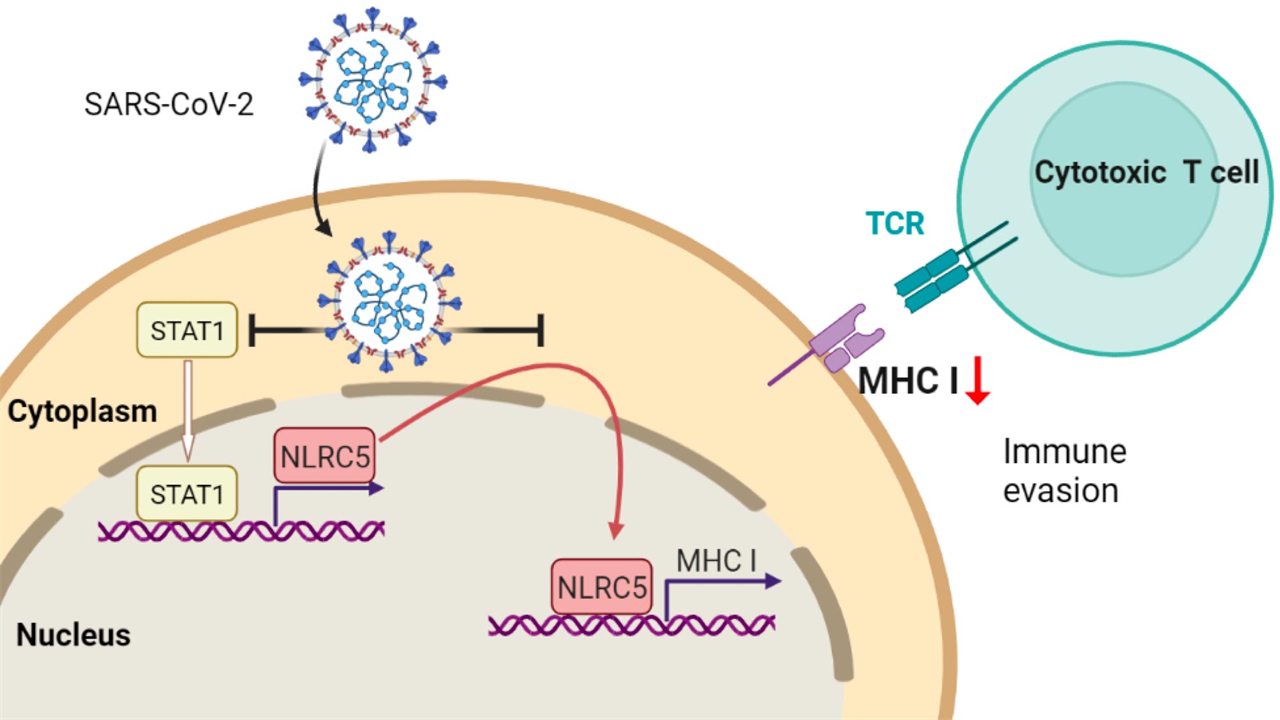How the COVID-19 Virus Evades Our Immune System
0 View
Share this Video
- Publish Date:
- 9 December, 2021
- Category:
- Covid
- Video License
- Standard License
- Imported From:
- Youtube
Tags

The expression of the immune response gene NLRC5 (red-purple) is suppressed in SARS-CoV-2 (green) infected cells. Credit: Koichi Kobayashi
Scientists from Hokkaido University and Texas A&M University have identified a key mechanism used by the SARS-CoV-2 virus to evade the host’s immune system.
Researchers in Japan and the United States have found that SARS-CoV-2 can shut down an important molecular pathway linked to an immune complex called MHC class I. The finding should help scientists better understand how the COVID-19 infection occurs .
“Our discovery shows how the virus can evade the human immune system and could help explain why the pandemic has been so severe,” said Koichi Kobayashi, an immunologist at Hokkaido University and Texas A&M University who led the study. “The mechanisms we identify may provide novel molecular targets for drug discovery.”
SARS-CoV-2 escapes immune responses by cytotoxic T cells via reduced MHC-I expression caused by reducing both the amount and function of NLRC5. Credit: Koichi Kobayashi
The scientists used a bioinformatics approach to look at how SARS-CoV-2, the virus that causes COVID-19, changes gene expression in the immune system of COVID-19 patients compared to uninfected individuals. This is a convenient way to investigate the function of complicated cell signaling pathways that trigger immune responses to fight harmful bacteria and viruses.
MHC (major histocompatibility complex) class I molecules are a central weapon in the immune response against viruses. When a virus infects a cell, the cell facilitates the expression of viral antigens on the surface of infected cells, attracting the attention of immune cells called cytotoxic T cells. These immune cells invade and destroy the infected cells, along with the invading virus inside.
Steven X. Cho, Ji-Seung Yoo, Koichi Kobayashi, Ryota Ouda (front row, from left) and Baohui Zhu (middle row, center left), contributing authors of the Department of Immunology, Graduate School of Medicine, Hokkaido University. Credit: Koichi Kobayashi
In addition to analyzing gene expression in COVID-19 patients, the research team also infected human cell lines with the SARS-CoV-2 virus to validate their findings.
The results showed that a SARS-CoV-2 virus protein called ORF 6 suppresses a host cell protein called NLRC5, which is responsible for activating the MHC class I pathway.
The study showed that this happens in two ways. ORF6 impedes cell signaling, turning off NLRC5 expression. ORF6 also blocks the function of NLRC5.
(From left) Yasuko Orba, Hirofumi Sawa, Michihito Sasaki, contributing authors of the Department of Molecular Pathobiology, International Institute for Zoonosis Control, Hokkaido University. Credit: Hirofumi Sawa
Other infectious viruses, including HIV and MERS, are also known to target the MHC class I pathway. Researchers believed SARS-CoV-2 likely did, but this study is the first to unravel the mechanism.
“Without the activation of the MHC class I pathway, viruses in the infected cells are essentially hidden from the immune system. That helps explain why the SARS-CoV-2 virus persists in the body and why it continues to infect others, leading to the pandemic,” Kobayashi said.
Yusuke Kasuga (Graduate School of Medicine, Hokkaido University), a contributing author of the article. Credit: Yusuke Kasuga
Further research could help find and test drugs that block the activity of the ORF6 viral protein, to restore the host cell’s ability to activate the major histocompatibility complex. If successful, such drugs can encourage the host’s immune system to clear the virus itself, effectively boosting the immune response.
To learn more about this study, see COVID-19 Breakthrough: Scientists Discover How the SARS-CoV-2 Virus Evades Our Immune System.
Reference: “SARS-CoV-2 inhibits the induction of the MHC class I pathway by targeting the STAT1-IRF1-NLRC5 axis” by Ji-Seung Yoo, Michihito Sasaki, Steven X. Cho, Yusuke Kasuga, Baohui Zhu, Ryota Ouda, Yasuko Orba, Paul de Figueiredo, Hirofumi Sawa, and Koichi S. Kobayashi, Nov. 15, 2021, Nature Communications.
DOI: 10.1038/s41467-021-26910-8










